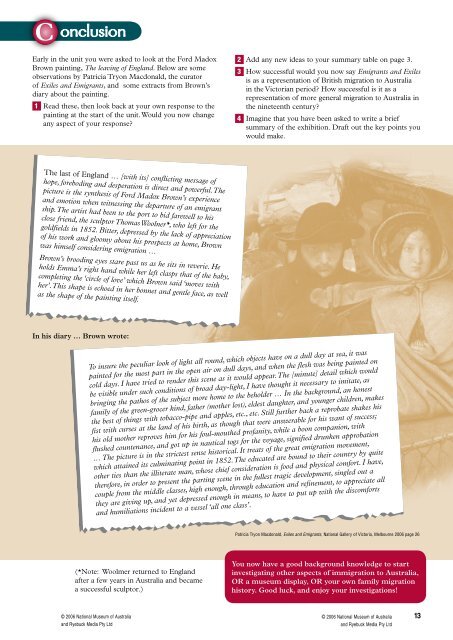Exiles and Emigrants - National Museum of Australia
Exiles and Emigrants - National Museum of Australia
Exiles and Emigrants - National Museum of Australia
- No tags were found...
You also want an ePaper? Increase the reach of your titles
YUMPU automatically turns print PDFs into web optimized ePapers that Google loves.
C onclusionEarly in the unit you were asked to look at the Ford MadoxBrown painting, The leaving <strong>of</strong> Engl<strong>and</strong>. Below are someobservations by Patricia Tryon Macdonald, the curator<strong>of</strong> <strong>Exiles</strong> <strong>and</strong> <strong>Emigrants</strong>, <strong>and</strong> some extracts from Brown’sdiary about the painting.1 Read these, then look back at your own response to thepainting at the start <strong>of</strong> the unit. Would you now changeany aspect <strong>of</strong> your response?2 Add any new ideas to your summary table on page 3.3 How successful would you now say <strong>Emigrants</strong> <strong>and</strong> <strong>Exiles</strong>is as a representation <strong>of</strong> British migration to <strong>Australia</strong>in the Victorian period? How successful is it as arepresentation <strong>of</strong> more general migration to <strong>Australia</strong> inthe nineteenth century?4 Imagine that you have been asked to write a briefsummary <strong>of</strong> the exhibition. Draft out the key points youwould make.The last <strong>of</strong> Engl<strong>and</strong> … [with its] conflicting message <strong>of</strong>hope, foreboding <strong>and</strong> desperation is direct <strong>and</strong> powerful. Thepicture is the synthesis <strong>of</strong> Ford Madox Brown’s experience<strong>and</strong> emotion when witnessing the departure <strong>of</strong> an emigrantship. The artist had been to the port to bid farewell to hisclose friend, the sculptor Thomas Woolner*, who left for thegoldfields in 1852. Bitter, depressed by the lack <strong>of</strong> appreciation<strong>of</strong> his work <strong>and</strong> gloomy about his prospects at home, Brownwas himself considering emigration …Brown’s brooding eyes stare past us as he sits in reverie. Heholds Emma’s right h<strong>and</strong> while her left clasps that <strong>of</strong> the baby,completing the ‘circle <strong>of</strong> love’ which Brown said ‘moves withher’. This shape is echoed in her bonnet <strong>and</strong> gentle face, as wellas the shape <strong>of</strong> the painting itself.In his diary … Brown wrote:To insure the peculiar look <strong>of</strong> light all round, which objects have on a dull day at sea, it waspainted for the most part in the open air on dull days, <strong>and</strong> when the flesh was being painted oncold days. I have tried to render this scene as it would appear. The [minute] detail which wouldbe visible under such conditions <strong>of</strong> broad day-light, I have thought it necessary to imitate, asbringing the pathos <strong>of</strong> the subject more home to the beholder … In the background, an honestfamily <strong>of</strong> the green-grocer kind, father (mother lost), eldest daughter, <strong>and</strong> younger children, makesthe best <strong>of</strong> things with tobacco-pipe <strong>and</strong> apples, etc., etc. Still further back a reprobate shakes hisfist with curses at the l<strong>and</strong> <strong>of</strong> his birth, as though that were answerable for his want <strong>of</strong> success;his old mother reproves him for his foul-mouthed pr<strong>of</strong>anity, while a boon companion, withflushed countenance, <strong>and</strong> got up in nautical togs for the voyage, signified drunken approbation… The picture is in the strictest sense historical. It treats <strong>of</strong> the great emigration movement,which attained its culminating point in 1852. The educated are bound to their country by quiteother ties than the illiterate man, whose chief consideration is food <strong>and</strong> physical comfort. I have,therefore, in order to present the parting scene in the fullest tragic development, singled out acouple from the middle classes, high enough, through education <strong>and</strong> refinement, to appreciate allthey are giving up, <strong>and</strong> yet depressed enough in means, to have to put up with the discomforts<strong>and</strong> humiliations incident to a vessel ‘all one class’.Patricia Tryon Macdonald, <strong>Exiles</strong> <strong>and</strong> <strong>Emigrants</strong>, <strong>National</strong> Gallery <strong>of</strong> Victoria, Melbourne 2006 page 26(*Note: Woolmer returned to Engl<strong>and</strong>after a few years in <strong>Australia</strong> <strong>and</strong> becamea successful sculptor.)You now have a good background knowledge to startinvestigating other aspects <strong>of</strong> immigration to <strong>Australia</strong>,OR a museum display, OR your own family migrationhistory. Good luck, <strong>and</strong> enjoy your investigations!© 2006 <strong>National</strong> <strong>Museum</strong> <strong>of</strong> <strong>Australia</strong><strong>and</strong> Ryebuck Media Pty Ltd© 2006 <strong>National</strong> <strong>Museum</strong> <strong>of</strong> <strong>Australia</strong><strong>and</strong> Ryebuck Media Pty Ltd13

















